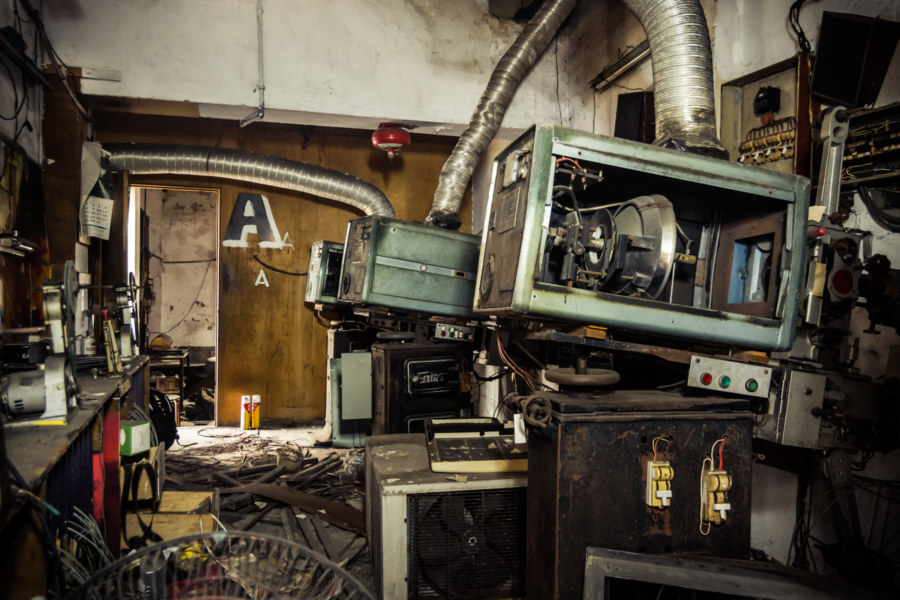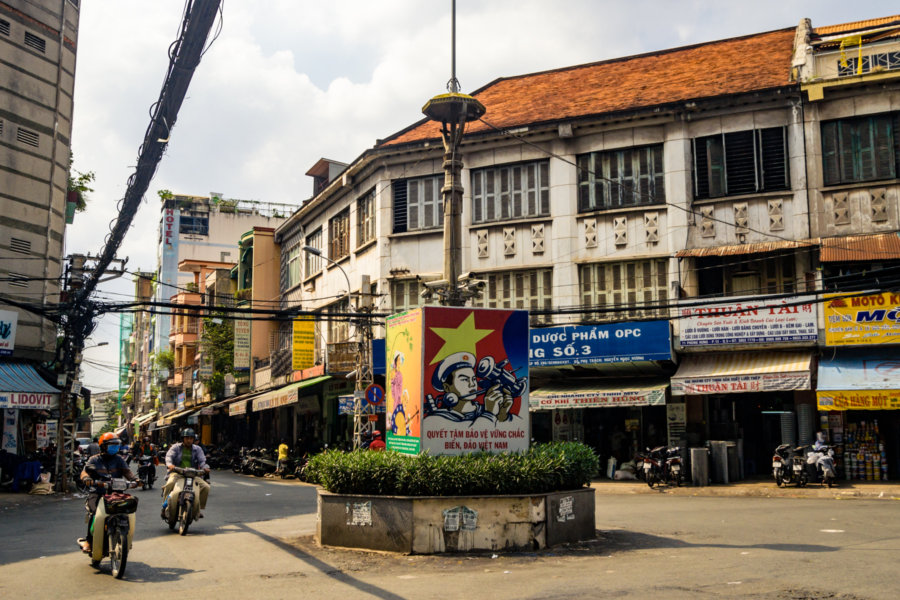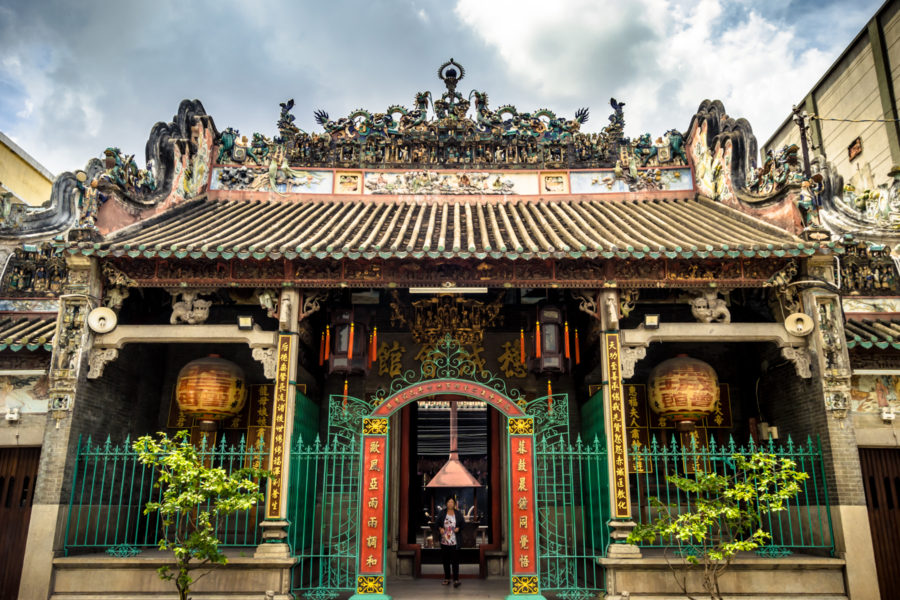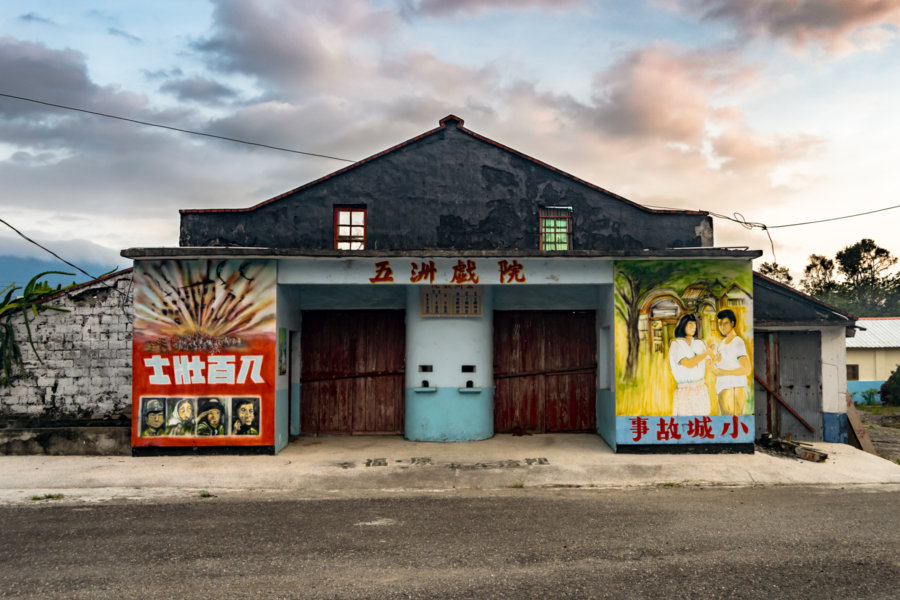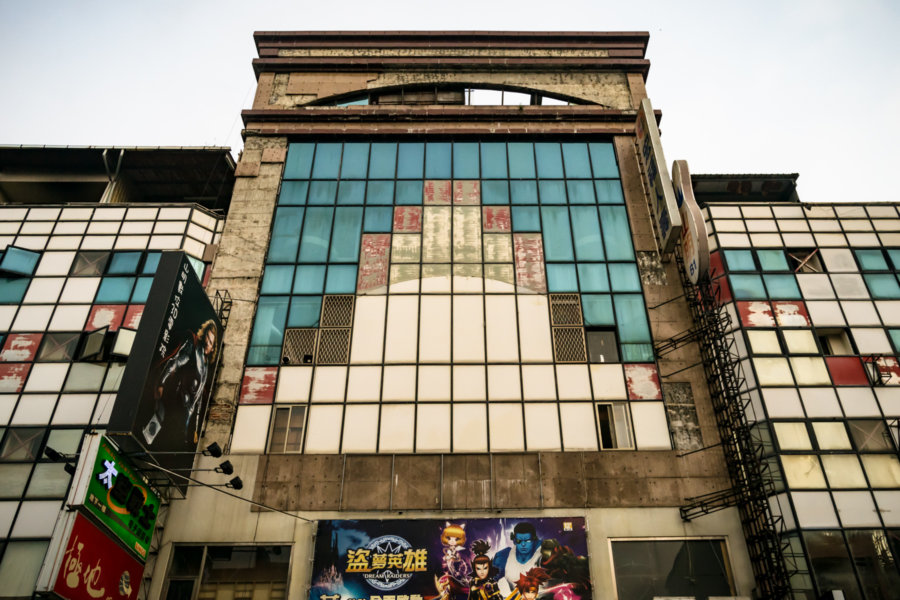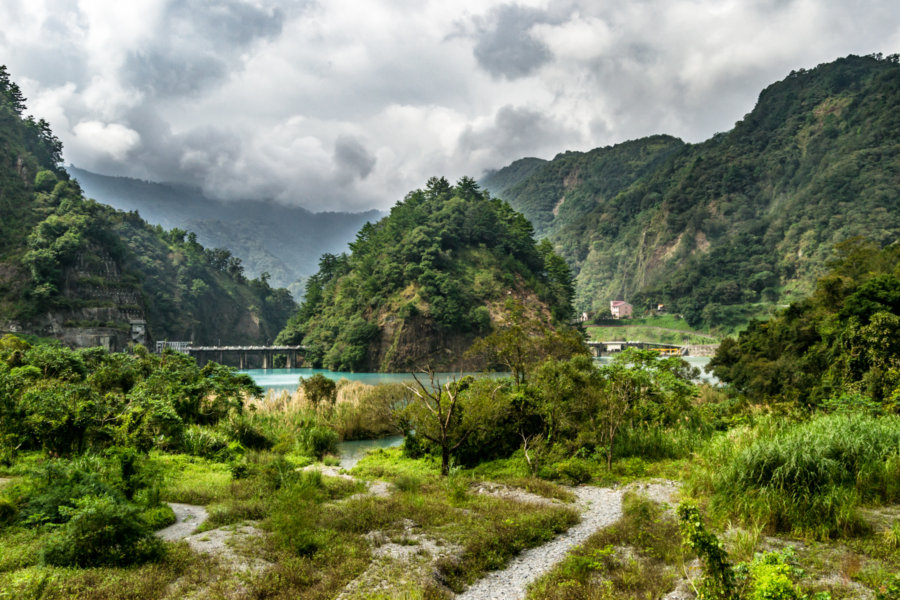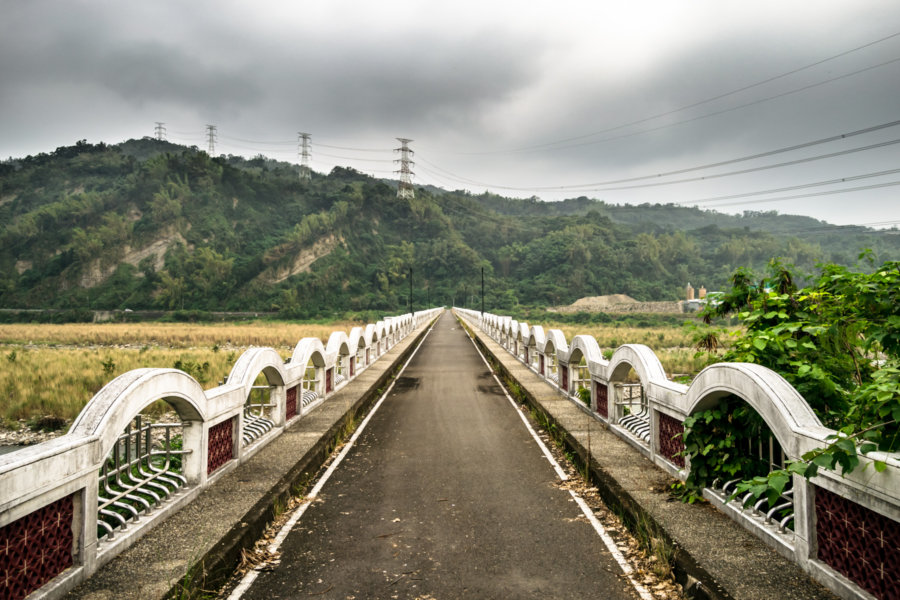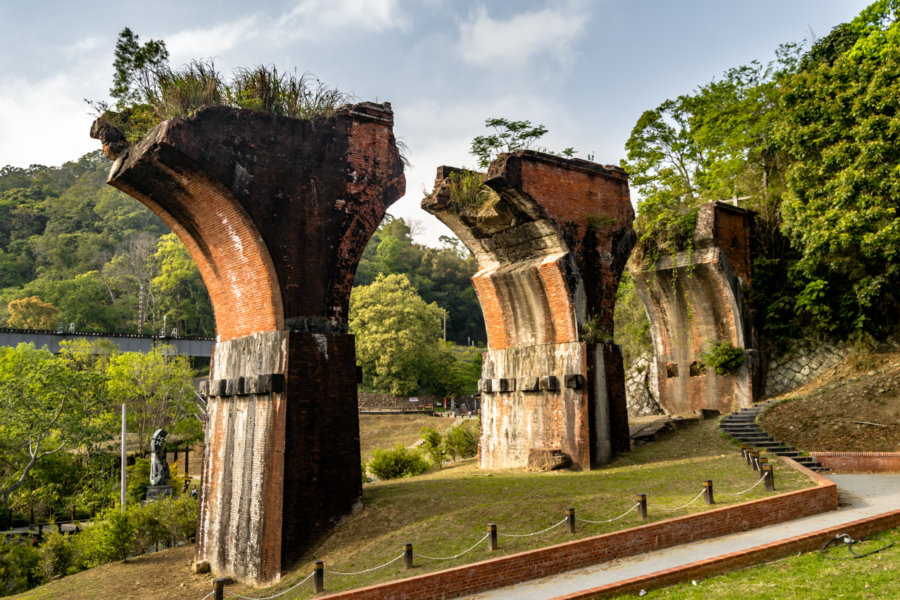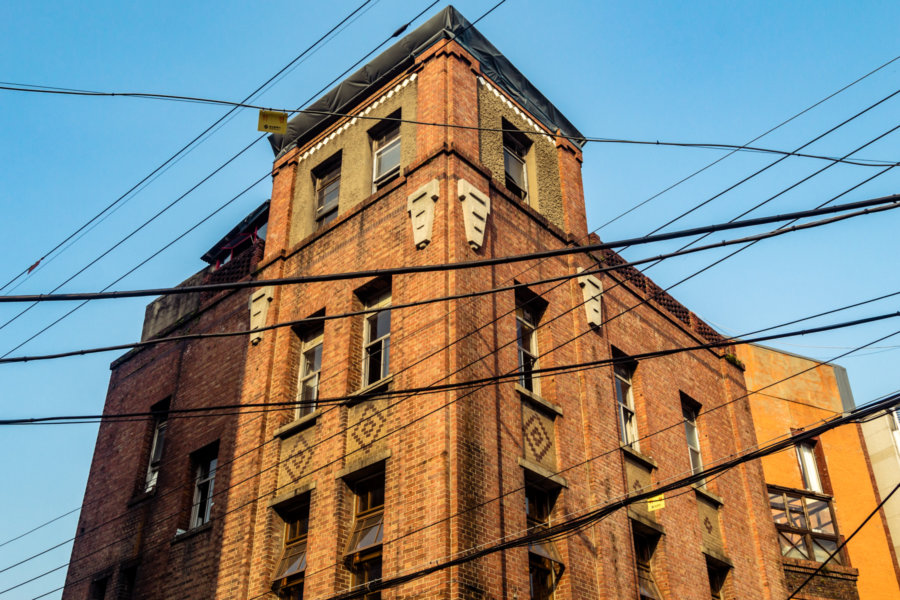In the summer of 2017 I embarked upon a series of road trips around central and southern Taiwan. I began in Taichung and ended up riding as far south as Kaohsiung over the course of several months. It was not one continuous journey; I would head south, ride for several days, stash the scooter at a train station, and return to my residence in Taipei before doing it all over again. There wasn’t a lot of planning involved, nor were these trips entirely random. Usually I had some idea of what to see and where to go, but there were also many serendipitous discoveries along the way. Ultimately I gathered material for more than 50 posts, many of which have already been published. This introductory post gathers an assortment of photos from the first segment of the trip from Taichung to Nantou, with particular emphasis on the districts of Taiping, Puli, and Shuili.
Zhongli Dadong Theater 中壢大東戲院
Zhongli is home to a surprising number of disused and abandoned cinemas, relics of a lost age of theater in this conurbation of half a million sprawling across the central Taoyuan Plateau 桃園台地. Decades ago there were nearly two dozen standalone movie theaters in town—but only Zhongyuan Theater 中源大戲院, one of two in Taiwan still displaying hand-painted movie posters, clings to life as of 2018. Most of the others have been renovated beyond recognition or demolished, but several more are derelict, hard-worn subjects of entropy. Among these relics there are none more alluring than the imposing Dàdōng Theater 大東戲院 (literally the “Great Eastern Theater”), former anchor of Zhongli’s long-vanished Cinema Street 戲院街.
Postcards From Cholon
Cholon is a historic Chinatown west of old Saigon in Ho Chi Minh City, Vietnam. I visited the area on three occasions in 2017, intent on wandering around and capturing some pictures from the streets. Previously I published an extensive report on the Chinese temples of Cholon, including some detail about the history and demographics of the area, so I won’t repeat myself in this post. Instead, I’ll let the photos do the talking this time around…
The Chinese Temples and Guildhalls of Cholon
On several recent trips to Ho Chi Minh City I spent some time wandering around Cholon, a vast and historic Chinatown located about five kilometers west of the downtown core of colonial Saigon. Originally settled in the late 17th century by ethnic Chinese settlers, the Hoa People 華人, it was known by its Cantonese name, Tai-Ngon 堤岸 (literally “Embankment”, but it is also roughly homophonous with “Saigon”). Later the Vietnamese dubbed it Cholon (“Big Market”) after the forerunner of the modern-day Binh Tay Market. The Hoa people were once the majority in Cholon but many fled persecution in the aftermath of Fall/Liberation of Saigon in 1975, and again during the Sino-Vietnamese War. Nowadays the Hoa people only account for approximately 5% of the population of Ho Chi Minh City (less than half the proportion of ethnic Chinese living in Toronto, my hometown) but their imprint on the streets of Cholon is readily apparent, particularly in the form of the many distinctive temples and guildhalls of the district.
Chishang Wuzhou Theater 池上五洲戲院
Wǔzhōu Theater (五洲戲院) is the last remnant of cinema in Chishang, Taitung, a picturesque town located in the fertile Huadong Valley of Taiwan. Built in 1965 in the midst of the Taiwan Economic Miracle, it remained in business until 1982. After the final screening the theater was neglected for decades, falling into disrepair but remaining more or less intact until recently. More recently Chishang emerged as a tourist destination, prompting a local community development association to invest in revitalizing the theater in 2013.
Nantou Road Trip 2015: Puli
Puli was my home base for several days of road tripping and adventure around Nantou in October 2015. Recently I decided to publish my findings and impressions from this trip despite not knowing much about what I was seeing at that time. Most of the other posts in this series document trips from one place to another but in this post I’m focusing on some of what I found within city limits, starting with some history to put everything in context.
Nantou Road Trip 2015: Ren’ai
My second day on the road in Nantou County in October 2015 was completely unplanned. I left Puli and headed deeper into the mountains simply to see what was there, not having done any advance research. From a glance at the map I had a rough idea where I’d be going—deeper into traditional Taiwanese Indigenous lands to the east of Puli Basin (埔里盆地). Ultimately I ended up visiting several settlements and two reservoirs in a few hours of riding around what is now known as the township of Ren’ai.
Nantou Road Trip 2015: Taichung to Puli
In October 2015 I set out from Taichung to attend a music festival in Nantou, the landlocked county in the mountainous interior of Taiwan. Since I don’t often have an opportunity to ride a scooter I allocated some extra time for onward exploration and ended up visiting many interesting and wonderful places, many of them quite obscure. What follows is the first part of a mostly visual record of this road trip around the geographic center of Taiwan…
Longteng Broken Bridge 龍騰斷橋
Lóngténg Broken Bridge (龍騰斷橋) is a historic roadside attraction in the rolling hills of Sanyi in southern Miaoli, Taiwan. More formally known as Yúténgpíng Broken Bridge (魚藤坪斷橋), it was originally constructed in 1907 during the Japanese colonial era, connecting Zhunan and Taichung along what is now known as the Old Mountain Line (舊山線). The bridge collapsed during the devastating 1935 Hsinchu-Taichung Earthquake but the ruins were never cleared away. Further damage was done in the 921 Earthquake in 1999. Several years later, in 2003, it was designated a historic site by the county government and subsequently developed for tourism along with the former Shèngxìng Railway Station (勝興車站).
Baekje Hospital
The former Baekje Hospital is a heritage building in Busan, the second largest city in South Korea. Built in 1922 by Choi Yong-hae, a Korean living in Japan, it is located in Choryang, Busan’s historic Chinatown. It was the first private hospital in the city but only remained in business for about a decade before the building was repurposed. Over the years the former hospital has been used as army barracks, police station, Chinese restaurant, wedding hall, and more. This was even the home of a consulate for the Republic of China (now generally known as Taiwan) at some point, probably long before diplomatic recognition ended in 1992.

